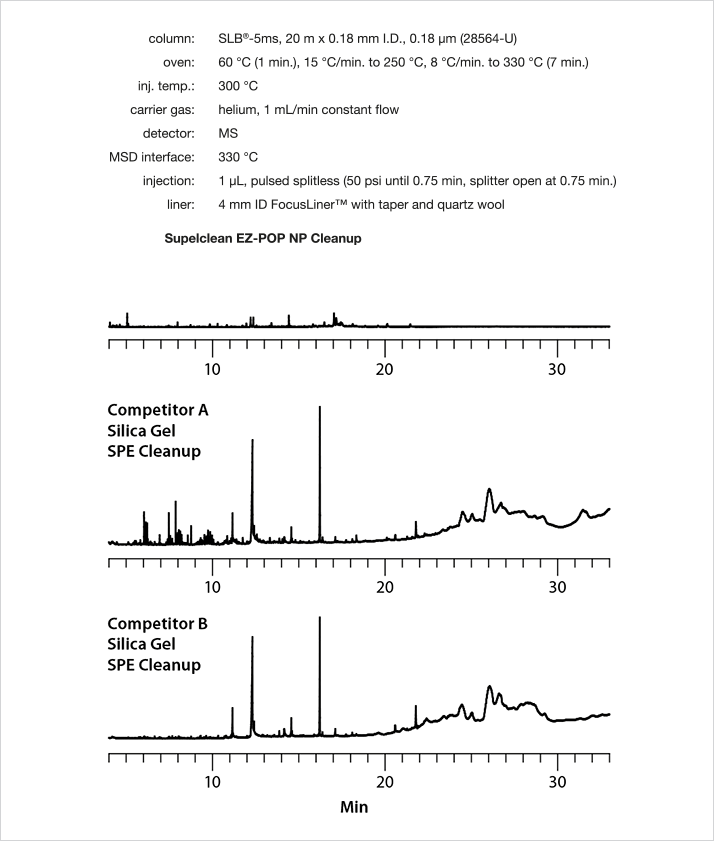Introduction
A recent survey implemented by Supelco revealed that 58% of analytical chemists in the food industry find the analysis of compounds in fatty matrices to be highly problematic. Lipid interferences can produce elevated detection limits, contamination of LC and GC systems, and ultimately decrease instrument and column lifetime.
Current extraction and cleanup techniques for fatty samples may be time consuming, expensive, and/or provide insufficient background removal prior to analysis. For this reason, a new approach has been developed. The Supelclean EZ-POP NP, a dual-layer SPE cartridge containing Florisil® and Z-Sep/C18, was designed for the extraction of nonpolar analytes from oil matrices. By means of Lewis acid/base and hydrophobic interactions, fatty matrix interferences are preferentially retained by the cartridge while analytes of interest are eluted. In this way, lipid interferences are removed from the sample.

Experimental
The Supelclean EZ-POP NP and two competitor silica gel SPE cartridges were compared in terms of matrix removal and analyte recovery for the extraction of select polycyclic aromatic hydrocarbons (PAHs) from olive oil. Multiple replicates of both unspiked and spiked (20 ng/g with PAHs) oil samples were processed for each SPE cleanup technique. The cleanup procedures are summarized in Tables 1 and 2.Table 1. Cleanup Procedure for Olive Oil using Supelclean EZ-POP NP
- 1. Add 10 mL of acetone to the Supelclean EZ-POP NP cartridge (54341-U), and allow it to elute with gravity.
- Dry the cartridge at -10" Hg for 10 min.
- Accurately weigh 0.500 mL of oil directly onto the SPE cartridge.
- Add the internal standard directly to the oil on the cartridge.
- Allow the sample to penetrate the upper frit.
- Pulling vacuum, elute the analytes of interest with 15 mL of acetonitrile (rate of approximately 1 drop/sec.).
- Concentrate the samples to a final volume of 1 mL under nitrogen (5 psi) at 40 °C.
Table 2. Cleanup Procedure for Olive Oil using Silica Gel SPE Cartridges (Competitor A and B)1*
- Condition the SPE cartridges with 20 mL of hexane.
- Dilute 5 g of oil with hexane to a final volume of 10 mL. Load 1 mL onto the cartridge. Add the internal standard directly onto the cartridge.
- Wash the cartridge with 8 mL hexane:methylene chloride (70:30).
- Elute the analytes of interest with 8 mL hexane:methylene chloride (70:30).
- Concentrate the samples to a final volume of 1 mL under nitrogen (5 psi) at 40 °C.
* Gravity elution was used for the above ste Extracts were then analyzed by GC-MS (SIM mode). Quantitation was performed against a 5-point calibration curve (1–20 ng/mL) prepared in unspiked olive oil extract with naphthalene-d8, fluoranthene-d10, perylene-d12 internal standards, spiked at 10 ng/mL.
Results and Discussion
Matrix Removal Figure 1 shows the GC-MS (full scan) chromatograms of the extracts after cleanup with Supelclean EZ-POP NP, Competitor A silica gel SPE, and Competitor B silica gel SPE, respectively. The chromatograms illustrate that the EZ-POP NP cleanup produces much lower background than the silica gel SPE cleanup.
 Figure 1: GC-MS Full Scan Chromatograms of Olive Oil Extract (same y axis)
Figure 1: GC-MS Full Scan Chromatograms of Olive Oil Extract (same y axis)




